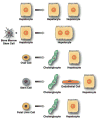Cell therapies for liver diseases
- PMID: 22140063
- PMCID: PMC3245367
- DOI: 10.1002/lt.22467
Cell therapies for liver diseases
Abstract
Cell therapies, which include bioartificial liver support and hepatocyte transplantation, have emerged as potential treatments for a variety of liver diseases. Acute liver failure, acute-on-chronic liver failure, and inherited metabolic liver diseases are examples of liver diseases that have been successfully treated with cell therapies at centers around the world. Cell therapies also have the potential to be widely applied to other liver diseases, including noninherited liver diseases and liver cancer, and to improve the success of liver transplantation. Here we briefly summarize current concepts of cell therapy for liver diseases.
Copyright © 2011 American Association for the Study of Liver Diseases.
Figures



References
-
- Kobayashi N, Noguchi H, Fujiwara T, Westerman KA, Leboulch P, Tanaka N. Establishment of a highly differentiated immortalized adult human hepatocyte cell line by retroviral gene transfer. Transplantation proceedings. 2000;32(7):2368–9. - PubMed
-
- Han B, Lu Y, Meng B, Qu B. Cellular loss after allogenic hepatocyte transplantation. Transplantation. 2009;87:2009. - PubMed
-
- Matas AJ, Sutherland DE, Steffes MW, Mauer SM, Sowe A, Simmons RL, et al. Hepatocellular transplantation for metabolic deficiencies: decrease of plasms bilirubin in Gunn rats. Science. 1976;192(4242):892–4. - PubMed
Publication types
MeSH terms
Grants and funding
LinkOut - more resources
Full Text Sources
Other Literature Sources
Medical
